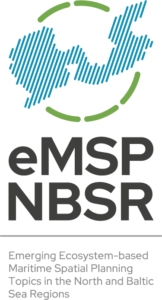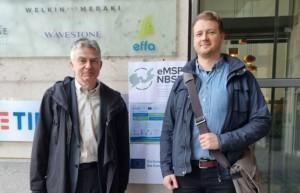Maritime Spatial Planning reconciles maritime functions and promotes seafood production as part of Finland’s security of supply
 Finland’s maritime spatial planning authorities are involved in a joint maritime spatial planning project covering the Baltic Sea and the North Sea. The project is known as eMSP NBSR. One of the key activities under the project is to support blue growth through maritime spatial planning. Olli Rönkä, a spatial planner from the Regional Council of Lapland, has met developers and entrepreneurs aiming to increase the amount of sustainable seafood production.
Finland’s maritime spatial planning authorities are involved in a joint maritime spatial planning project covering the Baltic Sea and the North Sea. The project is known as eMSP NBSR. One of the key activities under the project is to support blue growth through maritime spatial planning. Olli Rönkä, a spatial planner from the Regional Council of Lapland, has met developers and entrepreneurs aiming to increase the amount of sustainable seafood production.
Maritime spatial planning seeks to promote sustainable seafood production and reconcile its needs with other ways of using the sea. In March, a workshop was held in Brussels as part of the eMSP NBSR project. The workshop’s theme was Sustainable Blue Economy, and it was the first meeting to be held in person since the onset of the COVID-19 pandemic and the related restrictions. The aims included sharing information on best practices and considering new means of maritime spatial planning that could promote marine food production.
“Bringing together maritime spatial planners, experts, developers and entrepreneurs for a meeting in person was a significant step. The pressure to use maritime areas only increases during a crisis. The starting points for plans in different countries and, consequently, the plans themselves vary greatly. Finland has a huge amount of maritime space and the potential to develop activities. The maritime spatial plan recognises this potential, enabling new activities and providing flexibility,” says Olli Rönkä, whose special expertise is the Bothnian Bay in Sea Lapland, the northernmost area of marine food production in the EU.
 Photo: Heikki Saarento (left) and Olli Rönkä in Brussels, 22nd March 2022
Photo: Heikki Saarento (left) and Olli Rönkä in Brussels, 22nd March 2022
“The meeting between planners and maritime actors was the key to the workshop,” says Rönkä. “Although maritime spatial planning does not – and cannot – go into intricate detail, the substance competence of the entrepreneurs was eye-opening. Spatial planning can be a way of disseminating information, and it can drive development forward when areas are identified.”
Seafood production covers the traditional areas of fishing and fish farming, but it also encompasses the farming of seaweed and shellfish.
“Maritime spatial planning must identify effective means of supporting fishing activities. Eating farmed and wild fish from Finland is one form of climate action and part of the green transition because its carbon footprint is significantly smaller than that of producing meat or importing fish. It must be possible to treat fish farming equally in maritime spatial planning throughout the marine area of Finland. The national authorities should ensure they are heading in the same direction,” states Rönkä.
“Fishing and fish farming are a part of Finland’s security of supply, and we need to make sure that there is enough space in the sea for these activities. For example, maritime spatial planning plays an important role in safeguarding the stock of migratory fish,” says Rönkä, highlighting the example of the Tornionjoki river, which is an internationally significant river for migratory fish. “Climate change, the state of the marine environment and other marine users must be taken into account when considering how to safeguard viable stocks of salmon, trout and migratory lavaret (whitefish).”
The second round of maritime spatial planning began in early 2022, and planning will take a more positive approach to the development of maritime activities than before. In the best case, business activity can improve the state of the marine environment. It is important to highlight the positive effects and understand them in relation to the negative impacts. Nature inclusive design, which refers to the idea of considering nature in all activities, has become a more important focus for planning. Seaweed and shellfish farming will present new opportunities in Finland’s maritime areas and elsewhere in the Baltic Sea, which faces the challenge of high concentrations of nutrients in the water.
“It is noteworthy to think about the growth of seaweed in Finland’s marine areas. We have potential, and this field is completely under-exploited. Could a fish farmer also farm seaweed to compensate for nutrient emissions in the sea?” Rönkä puts the question out there for consideration. “I would like to discuss this matter at the workshop on Finnish seafood production.”
The national maritime spatial planning workshop on seafood production will be held in Turku on 23 August 2022. Experts and developers in the areas of fishing, fish farming, seaweed and shellfish farming are expected to attend the workshop in person. This is the first themed meeting in the second round of maritime spatial planning.
Website of the Learning Strand Sustainable Blue Economy, which is part of the eMSP NBSR project: https://www.emspproject.eu/project-activities/community-of-practice/sustainable-blue-economy/
Workshop on Maritime Spatial Planning and Finnish seafood production: Save the date! – Workshop on maritime spatial planning and seafood production in Turku on 23 Aug 2022 – Maritime Spatial Planning
